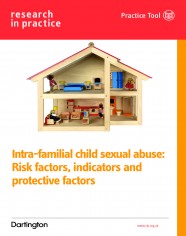
Intra-familial child sexual abuse: Risk factors, indicators and protective factors
Fiche mise à jour le 3 juillet 2019
En bref
Description
This resource is designed to support practitioners to use research evidence to structure their thinking in relation to intra-familial child sexual abuse (IFCSA). The idea is to use this alongside existing assessment processes, either while doing an assessment (to focus an analysis in relation to this issue) or when reviewing information that has already been gathered.
The three core sections address:
* Risks and vulnerabilities associated with IFCSA.
* Indicators (signs) associated with IFCSA.
* Factors that may protect children against IFCSA.
Aimed at: Practitioners working with children, young people and families - social workers, family support and youth workers.
Sommaire :* Terms and definitions
* Policy and practice context
* Poly-victimisation
* Cumulative and interacting risk of harm
* Child sexual abuse and children with disabilities
* Sexual abuse by siblings
* Technology-assisted abuse (online child sexual abuse)
* The impacts of child sexual abuse
* ‘Disclosure’ of abuse
* Section One: Risk factors and vulnerabilities associated with child sexual abuse
* Section Two: Indicators associated with intra-familial child sexual abuse
* Section Three: Protective factors associated with intra-familial child sexual abuse
* Section Four: Social work responses
Enfant handicapé, Trouble de l'apprentissage, Enfant malade, Victime mineure, Enfant maltraité, Inceste, Inceste fraternel, Vulnérabilité, Agression sexuelle intrafamiliale, Travail social, Pratique professionnelle, Guide de bonnes pratiques, guide méthodologique, Méthodologie, Cybercriminalité, Indicateur, Protection sociale, Travailleur social
Mots clés libres :

